Description
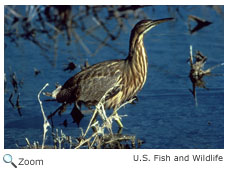 The American bittern is a medium-sized wading bird that is 23-34 inches in length with a wingspan of three feet. It is dark brown on its uppersides. Its underparts are streaked with brown, tan, and white. It has a pointed yellow bill, long legs, and a black stripe on the side of its throat. Males and females look alike. The American bittern is a medium-sized wading bird that is 23-34 inches in length with a wingspan of three feet. It is dark brown on its uppersides. Its underparts are streaked with brown, tan, and white. It has a pointed yellow bill, long legs, and a black stripe on the side of its throat. Males and females look alike.
Range
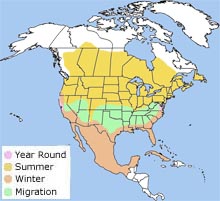 The American bittern breeds in wetlands across much of the United States and Canada. It winters along the Pacific Coast, the Gulf Coast, and the southern Atlantic Coast south to Mexico and the Caribbean. The American bittern breeds in wetlands across much of the United States and Canada. It winters along the Pacific Coast, the Gulf Coast, and the southern Atlantic Coast south to Mexico and the Caribbean.
Habitat
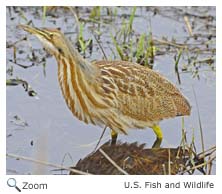 The American bittern is found in freshwater and brackish marshes and swamps. In the winter and during migration, it can be found in salt marshes. It prefers areas with thick clumps of tall plants like bulrushes, cattails, or sedges. While the American bittern is not listed as a federally endangered or threatened species, its population has decreased due to loss of habitat. The American bittern is found in freshwater and brackish marshes and swamps. In the winter and during migration, it can be found in salt marshes. It prefers areas with thick clumps of tall plants like bulrushes, cattails, or sedges. While the American bittern is not listed as a federally endangered or threatened species, its population has decreased due to loss of habitat. |
|
Diet
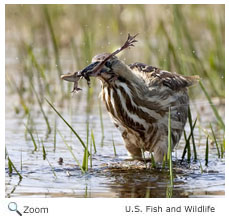 The American bittern eats small fish, eels, small snakes, salamanders, insects, frogs, crayfish, and small mammals. It stands still in the water and waits for its prey. When it spots something, it quickly goes after it and catches it in its bill. It then swallows its catch whole. The American bittern eats small fish, eels, small snakes, salamanders, insects, frogs, crayfish, and small mammals. It stands still in the water and waits for its prey. When it spots something, it quickly goes after it and catches it in its bill. It then swallows its catch whole.
Life Cycle
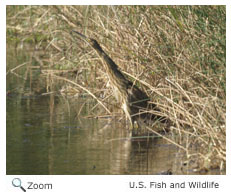 The American bittern mates in early May. The female chooses a nesting site and builds a platform nest of reeds, cattails, sedges, and other plant matter near the water. She lays 2-6 eggs at a rate of one egg a day. The female incubates the eggs and cares for the young. The eggs hatch in 24-28 days and the chicks leave the nest when they are a week or two old. The female continues to care for them for another two or three weeks. The American bittern mates in early May. The female chooses a nesting site and builds a platform nest of reeds, cattails, sedges, and other plant matter near the water. She lays 2-6 eggs at a rate of one egg a day. The female incubates the eggs and cares for the young. The eggs hatch in 24-28 days and the chicks leave the nest when they are a week or two old. The female continues to care for them for another two or three weeks.
Behavior
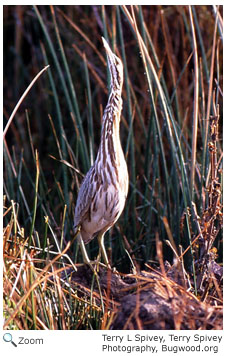 The American bittern has a distinctive loud booming "unk-a-chunk, unk-a-chunk" call that sounds like a machine! In fact, the American bittern is more often heard than seen! The American bittern relies on camouflage coloration to protect it from predators. It spends most of its time hidden in the reeds. When a threat approaches, it either freezes in place or stretches its neck up towards the sky and sways back and forth. The stripes on its breast and belly look like reeds waving in the breeze and a predator may be fooled. If that doesn't work, the American bittern calls out with its loud booming voice and flies away. The American bittern has a distinctive loud booming "unk-a-chunk, unk-a-chunk" call that sounds like a machine! In fact, the American bittern is more often heard than seen! The American bittern relies on camouflage coloration to protect it from predators. It spends most of its time hidden in the reeds. When a threat approaches, it either freezes in place or stretches its neck up towards the sky and sways back and forth. The stripes on its breast and belly look like reeds waving in the breeze and a predator may be fooled. If that doesn't work, the American bittern calls out with its loud booming voice and flies away.
|